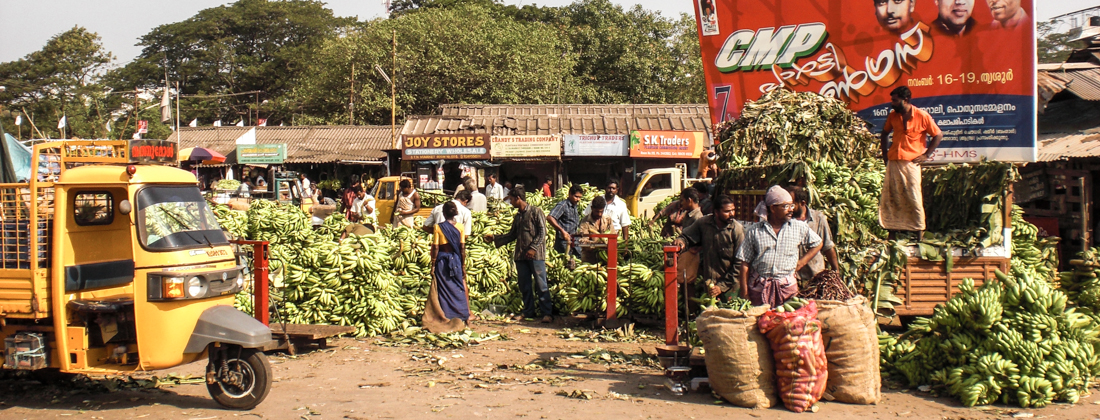
Tamil Nadu and Kerala I
A 14-day adventure trip across South India
From the Coromandel coast to the Malabar coast – Exquisite cultural highlights – Spectacular experience of nature – Mountains and backwaters of Kerala
This 14-day trip gives you a chance to experience an intense immersion into the natural and cultural diversity of Tamil Nadu and Kerala. The tour takes you from coast to coast, right across South India. You experience unique natural landscapes and explore a fascinating culture, giving you a unique insight into the living tradition and ritualized world of Hinduism. In the first days, the imposing Dravidian temples of Tamil Nadu take center stage. You will then be led up to the green tea plantations and spice gardens of the South Indian mountains. With a bit of luck, you’ll get to see elephants and other wild animals in their natural habitat when you visit a wildlife reserve. Kerala is world famous for its numerous lagoons and canals; lined by palms, mango trees and rice paddies, they crisscross the state and are also known as the Backwaters. Exploring these magical waterways on a house boat trip will be a special highlight of your trip. To conclude the tour, you enjoy the long sandy beach of Marari and let yourself be inspired by the cultural diversity of the Malabar Coast.
The proposed itinerary is flexible and can be tailored to your needs in terms of content and schedule. If you’d prefer an extended trip, we can recommend a well-maintained resort in Kerala that offers a stylish natural framework for relaxed days at the beach or rejuvenating Ayurvedic treatment.
Chennai – Mahabalipuram – Pondicherry – Auroville – Chidambaram – Thanjavur – Madurai – Thekkady – Backwaters – Marari – Cochin
Suggested itinerary:
Day 1: Arrival and transfer to Mahabalipuram
Your trip begins in Chennai, where you will be welcomed at the airport or train station and driven to your hotel in Mahabalipuram. The friendly atmosphere of the beach resort will help ensure that your arrival is a peaceful experience.
Day 2: World Heritage Sites in Mahabalipuram – Transfer to Puducherry (Pondicherry)
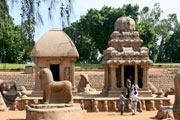 In Mahabalipuram (also called Mamallapuram) one can combine beach fun with a bit of cultural history. Situated directly on the Coromandel coast, the site is regarded as the cradle of South Indian culture and is a true archaeological treasure trove, with masterpieces from the Pallava period (6th – 8th century). In 1985, the monuments were declared a UNESCO World Heritage Site. Attractions include the Monolith temple and the Cave temple, with its magnificent imagery of the gods. It was the first temple in the region constructed from stone blocks. Large reliefs chiseled in granite narrate well known legends of Hindu mythology. The monolithic “Five Rathas” monuments served as architectural models on the basis of which the fundamental elements of Dravidian temple construction were developed. A huge boulder, located on a steep rocky ridge, is known as “Krishna’s Butterball” and presents a popular photo opportunity. Mahabalipuram is also a center of traditional sculpture. Indian statues of the gods in granite, marble and soapstone are still made by hand here in small family businesses. After the tour, a transfer to Puducherry (Pondicherry) follows.
In Mahabalipuram (also called Mamallapuram) one can combine beach fun with a bit of cultural history. Situated directly on the Coromandel coast, the site is regarded as the cradle of South Indian culture and is a true archaeological treasure trove, with masterpieces from the Pallava period (6th – 8th century). In 1985, the monuments were declared a UNESCO World Heritage Site. Attractions include the Monolith temple and the Cave temple, with its magnificent imagery of the gods. It was the first temple in the region constructed from stone blocks. Large reliefs chiseled in granite narrate well known legends of Hindu mythology. The monolithic “Five Rathas” monuments served as architectural models on the basis of which the fundamental elements of Dravidian temple construction were developed. A huge boulder, located on a steep rocky ridge, is known as “Krishna’s Butterball” and presents a popular photo opportunity. Mahabalipuram is also a center of traditional sculpture. Indian statues of the gods in granite, marble and soapstone are still made by hand here in small family businesses. After the tour, a transfer to Puducherry (Pondicherry) follows.
Day 3: Puducherry (Pondicherry) & Auroville
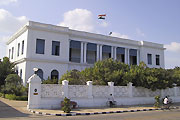 Puducherry (Pondicherry) is a town with a pleasant atmosphere and peaceful charm. It is situated in the union territory of the same name, and had been in French hands for almost three centuries. Pondicherry – renamed Puducherry in 2006 – as with other French enclaves, was only returned to the Indian government in 1954. Its French characteristics and its location on the Bay of Bengal make the city a popular tourist destination. The French way of life has left its mark, especially in the former colonial district near the waterfront. Architecturally, the combination of French influences and traditional Indian design is interesting. An evening stroll along the beach promenade offers an opportunity to visit the Gandhi Memorial, a city landmark. Pondicherry is also home to the ashram of Sri Aurobindo. Born in Calcutta in 1872, this freedom fighter, yogi and philosopher is one of the great spiritual masters of the 20th century. He developed a method of spiritual practice known as “Integral Yoga”.
Puducherry (Pondicherry) is a town with a pleasant atmosphere and peaceful charm. It is situated in the union territory of the same name, and had been in French hands for almost three centuries. Pondicherry – renamed Puducherry in 2006 – as with other French enclaves, was only returned to the Indian government in 1954. Its French characteristics and its location on the Bay of Bengal make the city a popular tourist destination. The French way of life has left its mark, especially in the former colonial district near the waterfront. Architecturally, the combination of French influences and traditional Indian design is interesting. An evening stroll along the beach promenade offers an opportunity to visit the Gandhi Memorial, a city landmark. Pondicherry is also home to the ashram of Sri Aurobindo. Born in Calcutta in 1872, this freedom fighter, yogi and philosopher is one of the great spiritual masters of the 20th century. He developed a method of spiritual practice known as “Integral Yoga”.
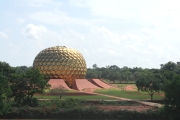 The Integral Yoga of Sri Aurobindo forms the underlying spiritual foundation of Auroville, an international township in the making, founded in 1968. About 2400 members from over 45 nations reside there. The aim of the community is the realization of human unity through the process of a collaborative effort to build the city. The spiritual center is the Matrimandir, a spherical building with a rather extraordinary meditation room. The Visitor’s Information Centre offers exhibitions and video tutorials, giving visitors a comprehensive overview of the ideal and the activities of Auroville. On request, a free pass is issued for a visit to the “Viewing Terrace” in the Matrimandir garden.
The Integral Yoga of Sri Aurobindo forms the underlying spiritual foundation of Auroville, an international township in the making, founded in 1968. About 2400 members from over 45 nations reside there. The aim of the community is the realization of human unity through the process of a collaborative effort to build the city. The spiritual center is the Matrimandir, a spherical building with a rather extraordinary meditation room. The Visitor’s Information Centre offers exhibitions and video tutorials, giving visitors a comprehensive overview of the ideal and the activities of Auroville. On request, a free pass is issued for a visit to the “Viewing Terrace” in the Matrimandir garden.
Day 4: Nataraja temple of Chidambaram & bronze workshops in Swamimalai
Auf dem Transfer nach Thanjavur besuchen Sie den weltbekannten Tempel des tanzenden Shiva und ein traditionelles Zentrum südindischer Handwerkskunst.
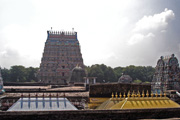 On the way to Thanjavur, you will visit the famous temple of the dancing Lord Shiva and a traditional center of South Indian craftsmanship.
On the way to Thanjavur, you will visit the famous temple of the dancing Lord Shiva and a traditional center of South Indian craftsmanship.
Surrounded by four imposing temple towers, the Nataraja temple in Chidambaram is one of the holiest places in South India. Numerous ceremonies and a traditional atmosphere offer fascinating insight into the ritualized world of Hinduism. Shiva is worshiped here in the form of Nataraja who expresses five forces through his cosmic dance: creation, preservation, destruction, illusion and grace. The construction of the 600 x 495 m large temple complex was started in the 10th century by the Chola dynasty. Characteristic of the Dravidian style is a rectangular floor plan and a firm geometric structure. The 40 m high gopurams (gateway towers) form the entrance gateways to the courtyard, which contains the central sanctum, the temple pond and several secondary shrines. The western and eastern gateway are decorated with the entire 108 basic positions of South Indian Bharatanatyam dance.
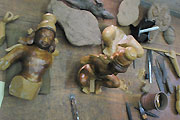 The small town of Swamimalai is a traditional center of South Indian bronze casting. Statues of the gods are still made by hand here in bronze and other metals, in small craft associations and family businesses. The traditional moulds were developed nearly 1,000 years ago during the Chola period and are still considered perfect images of the represented deities. The challenge for the artist is to make a perfect reproduction of the material form and the divine characteristics it expresses. The masters of this traditional craft happily invite visitors into the workshops to get an impression of their ancient craft, which requires the preparation of a wax mould prior to the production of each sculpture.
The small town of Swamimalai is a traditional center of South Indian bronze casting. Statues of the gods are still made by hand here in bronze and other metals, in small craft associations and family businesses. The traditional moulds were developed nearly 1,000 years ago during the Chola period and are still considered perfect images of the represented deities. The challenge for the artist is to make a perfect reproduction of the material form and the divine characteristics it expresses. The masters of this traditional craft happily invite visitors into the workshops to get an impression of their ancient craft, which requires the preparation of a wax mould prior to the production of each sculpture.
Day 5: World Heritage Site Thanjavur – Art Gallery & Brihadeeswarar Temple
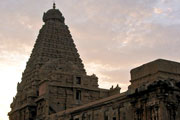 Thanjavur represents South Indian advanced civilization and is now a World Heritage Site. The art gallery in the Nayak Palace has an impressive collection of ancient bronzes from the Chola period and is known worldwide. The Brihadeeswarar temple, dedicated to Lord Shiva, was built in a record time of 6 years at the end of the 10th century by the Chola ruler Rajaraja I, and is considered a sublime masterpiece of Dravidian temple architecture. The site is characterized by its balanced design. After passing two entrance towers guarded by stern-looking dwarapalakas (door guards), the visitor enters the spacious courtyard with the majestic sanctuary at its center. The 16-storey high building above the main chamber is crowned by an 80-ton monolithic dome. After sunset, the temple complex is illuminated by spotlights, emanating an almost mystical atmosphere.
Thanjavur represents South Indian advanced civilization and is now a World Heritage Site. The art gallery in the Nayak Palace has an impressive collection of ancient bronzes from the Chola period and is known worldwide. The Brihadeeswarar temple, dedicated to Lord Shiva, was built in a record time of 6 years at the end of the 10th century by the Chola ruler Rajaraja I, and is considered a sublime masterpiece of Dravidian temple architecture. The site is characterized by its balanced design. After passing two entrance towers guarded by stern-looking dwarapalakas (door guards), the visitor enters the spacious courtyard with the majestic sanctuary at its center. The 16-storey high building above the main chamber is crowned by an 80-ton monolithic dome. After sunset, the temple complex is illuminated by spotlights, emanating an almost mystical atmosphere.
Day 6: Transfer to Madurai – Meenakshi Temple – Highlight of Dravidian temple architecture
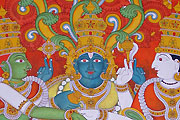 According to mythology, in Madurai Shiva took his consort Parvati to wife in the form of the beautiful Pandya princess Meenakshi. The Meenakshi temple, built in the 16th century during the Nayak period, represents the late stage of Dravidian temple architecture. Towards the north is the Sundareswarar temple, dedicated to Shiva in the form of Sundareswar, the beautiful lord. Both temples are part of an impressive overall complex which draws the visitor into a mystical world with the bright and colorful decoration of its temple towers, the half-dark colonnades, the traditional processions, the illuminated side shrines and the abundance of mythological motifs. Also worth seeing are the temple museum and the market with devotional items, housed in two large temple halls, where many pilgrims buy their souvenirs. Other attractions in Madurai are the Thirumalai Nayak Palace, built in the 17th century in Indo-Saracenic style, and the Gandhi Memorial Museum.
According to mythology, in Madurai Shiva took his consort Parvati to wife in the form of the beautiful Pandya princess Meenakshi. The Meenakshi temple, built in the 16th century during the Nayak period, represents the late stage of Dravidian temple architecture. Towards the north is the Sundareswarar temple, dedicated to Shiva in the form of Sundareswar, the beautiful lord. Both temples are part of an impressive overall complex which draws the visitor into a mystical world with the bright and colorful decoration of its temple towers, the half-dark colonnades, the traditional processions, the illuminated side shrines and the abundance of mythological motifs. Also worth seeing are the temple museum and the market with devotional items, housed in two large temple halls, where many pilgrims buy their souvenirs. Other attractions in Madurai are the Thirumalai Nayak Palace, built in the 17th century in Indo-Saracenic style, and the Gandhi Memorial Museum.
Day 7 and 8: Transfer to Munnar – Tea museum & hiking in the tea fields
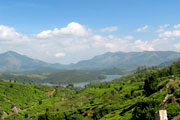 A varied drive through the picturesque countryside of southern India leads to a true paradise for nature lovers. Munnar, the “Queen of Hill Stations”, is surrounded by lush green tea plants at an altitude of 1,524 meters in the Kannan Devan hills of the Western Ghats. In the immediate vicinity is the Anamudi, the highest peak in South India at 2,965 m. The area around Munnar offers breathtaking views of the manicured tea fields that, depending on the weather, will glitter in the mild mountain sunlight or be enveloped in the mystical white of the clouds. A tea of a very special quality matures here, and the air is often permeated by the scent of freshly picked tea leaves. The area captivates, with its white-water streams, vast tea gardens, breathtaking views and rich animal life. A trip to Echo Point and Top Station will go past the scenic highlights of the region. A walk through the tea plantations with a local guide is highly recommended. A visit to the local tea museum reveals the secrets of tea production.
A varied drive through the picturesque countryside of southern India leads to a true paradise for nature lovers. Munnar, the “Queen of Hill Stations”, is surrounded by lush green tea plants at an altitude of 1,524 meters in the Kannan Devan hills of the Western Ghats. In the immediate vicinity is the Anamudi, the highest peak in South India at 2,965 m. The area around Munnar offers breathtaking views of the manicured tea fields that, depending on the weather, will glitter in the mild mountain sunlight or be enveloped in the mystical white of the clouds. A tea of a very special quality matures here, and the air is often permeated by the scent of freshly picked tea leaves. The area captivates, with its white-water streams, vast tea gardens, breathtaking views and rich animal life. A trip to Echo Point and Top Station will go past the scenic highlights of the region. A walk through the tea plantations with a local guide is highly recommended. A visit to the local tea museum reveals the secrets of tea production.
Day 9 and 10: Transfer to Thekkady – Spice gardens in the land where pepper grows – Walk in Periyar National Park
 In Thekkady, you are in the center of pepper-growing country. The small town is nestled between green tea, coffee and spice plantations in a typical South-Indian hilly landscape. Thekkady is probably the best place for buying Indian spices of the highest quality. On a visit to one of the many spice gardens, the various traditional spices can be directly experienced in nature, under the guidance of a professional. Another attraction is the Periyar National Park, which is among the best-known nature and wildlife sanctuaries in South India. On an early morning walk with local guides or on a boat ride on Periyar Lake, one can – with a little luck – spot elephants and a variety of other wild animals. A visit to a Kalaripayattu demonstration is also an impressive experience, providing insight into the traditional martial art of South India.
In Thekkady, you are in the center of pepper-growing country. The small town is nestled between green tea, coffee and spice plantations in a typical South-Indian hilly landscape. Thekkady is probably the best place for buying Indian spices of the highest quality. On a visit to one of the many spice gardens, the various traditional spices can be directly experienced in nature, under the guidance of a professional. Another attraction is the Periyar National Park, which is among the best-known nature and wildlife sanctuaries in South India. On an early morning walk with local guides or on a boat ride on Periyar Lake, one can – with a little luck – spot elephants and a variety of other wild animals. A visit to a Kalaripayattu demonstration is also an impressive experience, providing insight into the traditional martial art of South India.
Day 11: Transfer to Alappuzha (Alleppey) – House boat trip on the backwaters
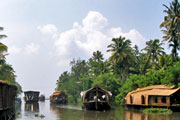 Kerala is famous around the world for its numerous waterways; lined by palms, mango trees and rice paddies, they crisscross the region and are known as the Backwaters. They form a vast network of waterways that extends from Kochi in the north to Kollam in the south, crossing an area of about 2000 square kilometers, consisting of 29 lakes and lagoons, 44 rivers and about 1500 canals. The largest lake, with a length of 83 km, is Vembanad Lake, which is connected to the Arabian Sea. The peaceful backwaters, serving as trade and transport routes for the locals for many centuries, are a spectacular destination for tourists. Discovering the picturesque water world on a house boat trip is an unforgettable highlight of a trip to Kerala. The romantic boats, providing all meals and comfortable accommodation for the night, are converted former rice barges. Your backwater trip starts and ends at the Alappuzha (Alleppey) boat jetty.
Kerala is famous around the world for its numerous waterways; lined by palms, mango trees and rice paddies, they crisscross the region and are known as the Backwaters. They form a vast network of waterways that extends from Kochi in the north to Kollam in the south, crossing an area of about 2000 square kilometers, consisting of 29 lakes and lagoons, 44 rivers and about 1500 canals. The largest lake, with a length of 83 km, is Vembanad Lake, which is connected to the Arabian Sea. The peaceful backwaters, serving as trade and transport routes for the locals for many centuries, are a spectacular destination for tourists. Discovering the picturesque water world on a house boat trip is an unforgettable highlight of a trip to Kerala. The romantic boats, providing all meals and comfortable accommodation for the night, are converted former rice barges. Your backwater trip starts and ends at the Alappuzha (Alleppey) boat jetty.
Day 12: Relaxing on the long sandy beach of Marari
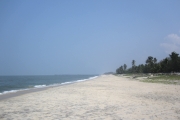 With a day in an elegant beach resort on the long sandy beach of Marari, you have the chance to relax in a stylish setting on Kerala’s legendary Malabar coast. Enjoy a swim in the Arabian Sea, indulge in an Ayurvedic massage and take a long walk on the beach.
With a day in an elegant beach resort on the long sandy beach of Marari, you have the chance to relax in a stylish setting on Kerala’s legendary Malabar coast. Enjoy a swim in the Arabian Sea, indulge in an Ayurvedic massage and take a long walk on the beach.
Day 13: Transfer to Cochin (Kochi) – Cultural diversity on the Malabar coast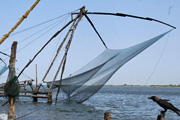
The port city of Kochi, formerly known as Cochin, is uniquely located between the Arabian Sea and the backwaters. With its rich ethnic and cultural heritage, Kochi’s atmosphere is an unforgettable experience. A variety of attractions offer insights into the rich history of the city, characterized by strong Portuguese and Dutch influences. Particularly interesting is a visit to Mattancherry and Fort Kochi, the historical city with its bustling life. Among the attractions for which sufficient time should be reserved are the winding streets with old Dutch houses, Chinese fishing nets at the waterfront, traditional spice markets, the antiquities quarter, the Jewish synagogue, the Mattancherry palace with its exquisite mythological murals and the St. Francis Church, built in 1503, where Vasco da Gama was buried until his remains were transferred to Lisbon in 1539. A special cultural attraction is the spectacular Kathakali dance theater. There are performances every evening.
Day 14: Leisurely stroll in Kochi (Cochin) and return home or travel onwards
 In the morning, there is time for a further exploration of Kochi. The unique location between the Arabian Sea and the backwaters invite the visitor to go on a tour of discovery using the local ferries, the main means of transportation between the various parts of the city. In this way, one can explore the port, the islands and the modern district of Ernakulam. Also recommended is a leisurely stroll through the antique and spice markets, which is concluded with a lunch at one of the many restaurants in the old town.
In the morning, there is time for a further exploration of Kochi. The unique location between the Arabian Sea and the backwaters invite the visitor to go on a tour of discovery using the local ferries, the main means of transportation between the various parts of the city. In this way, one can explore the port, the islands and the modern district of Ernakulam. Also recommended is a leisurely stroll through the antique and spice markets, which is concluded with a lunch at one of the many restaurants in the old town.
In the afternoon or evening, a transfer is made to the train station or airport to return home or travel onwards.
